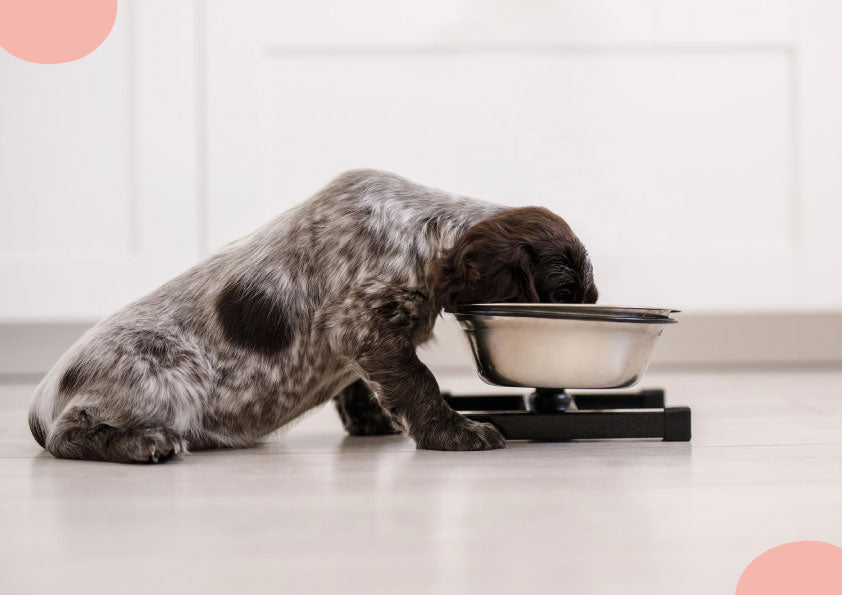My Dog Eats Too Fast: What to Do?

Nutrition plays a crucial role in your dog's health, but did you know that how they eat is just as important as what they eat? Eating too quickly may seem harmless, but this behavior hides real risks for your four-legged companion's health. From simple digestive discomfort to serious medical emergencies, the consequences of eating too fast should not be taken lightly. Fortunately, there are simple and effective methods to help your dog slow down their eating pace and thus preserve their health and well-being.
- The dangers of eating too quickly
- Slow down eating: practical tips
- Splitting meals
- Stimulate the mind and calm during mealtime
- When to consult your veterinarian
- FAQ
The dangers of eating too quickly
Eating too fast may seem trivial, but this behavior presents several health risks for your dog. By quickly swallowing their food, your dog often ingests excess air, which can lead to uncomfortable bloating. Worse still, it increases the risk of gastric torsion, a serious medical emergency where the stomach flips, blocking blood circulation and requiring immediate surgical intervention.
In addition to the risks of bloating and gastric torsion, a dog that eats too quickly is more likely to vomit undigested food, suffer from digestive problems, and not properly absorb nutrients. In the long term, these issues can lead to nutritional deficiencies and affect your dog's overall health.
Slow down eating: Anti-gulp bowls and practical tips
To prevent your dog from eating too fast, one of the simplest and most effective solutions is to use an anti-gulp bowl. These bowls are designed with internal obstacles that force your dog to eat more slowly. By making the dog navigate around these obstacles to reach their food, these bowls reduce the speed of ingestion and improve digestion.
Another tip is to add safe objects, like a clean tennis ball, directly into your dog's bowl. This creates an additional obstacle, further slowing down their eating pace.
Splitting meals for better control
Dividing your dog's daily ration into several small meals spread throughout the day is another effective method to reduce their eating speed. By offering multiple small meals, you prevent your dog from gobbling a large amount of food at once, which can help prevent bloating and other digestive problems.
This method is particularly useful for dogs that show signs of being overweight or tend to feel very hungry between meals. By splitting meals, you also help stabilize blood sugar levels, which can be beneficial for your dog's overall health.

Stimulate the mind and create a calm mealtime
Food-dispensing toys are an excellent way to slow down eating while mentally stimulating your dog. These toys force the dog to work to obtain their food, which not only slows down the speed of ingestion but also helps them expend mental energy.
Creating a calm environment during meals is also crucial. If your dog is stressed or excited while eating, it can contribute to their rapid consumption of food. Ensure that mealtime takes place in a quiet space, away from distractions, to encourage your dog to eat at a healthier pace.
When to consult your veterinarian
If, despite all these tips, your dog continues to eat too quickly or shows signs of recurring digestive problems, it is recommended to consult a veterinarian. There may be underlying causes for this behavior, such as appetite disorders, anxiety, or even medical issues that require special attention.
A veterinarian can also advise you on other methods or accessories to slow down your dog's eating or propose a diet adapted to their specific needs.
Eating too fast may seem like a simple inconvenience, but the health risks for your dog are very real. Fortunately, there are many solutions to slow down their eating pace and prevent complications. By using adapted bowls, splitting meals, and ensuring that mealtime is calm and soothing, you can greatly improve your dog's digestion and well-being. If problems persist despite your efforts, do not hesitate to consult a veterinarian for professional and personalized advice.
FAQ
Eating too quickly can lead to serious health problems for your dog, such as bloating, vomiting, and in extreme cases, gastric torsion, which is a medical emergency.
Signs that your dog is eating too quickly include consuming food within seconds, vomiting undigested food shortly after eating, and visible bloating of the abdomen.
You can slow down your dog's eating pace by using an anti-gulp bowl, adding obstacles in their bowl like a tennis ball, or splitting their meals into several small portions throughout the day.
Yes, anti-gulp bowls are designed to slow down eating by forcing your dog to navigate internal obstacles, which improves digestion and reduces the risks of bloating and gastric torsion.
If your dog continues to eat too quickly despite your efforts to slow down their eating pace, or if they show recurring signs of digestive problems, it is recommended to consult a veterinarian to assess any underlying health issues.





